Takeda We have received all the comments on all the prize winners other than each juror’s prize winners. There are five juror’s prizes. I’d like each juror to make some comments on his prize winner. First, Mr. Myers, please.
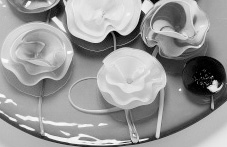 Myers I have to keep it short. If someone had asked if I had selected this piece, they would never have guessed that it was I who’ve selected, because it really is so far it is in a sense away from my aesthetic and yet there’s a very personal story that I will keep short. But since this piece is included in this exhibition, it has been recognized for its excellence but I didn’t vote for because I didn’t feel that it deserved no work. However, since this is a very personal prize. I decided to give it to a woman, a Swedish woman who has been working with glass for a very very long time, as a matter of fact, worked in Japan, Northern Japan as a resident for some period of time some years ago. She is a professional lady who makes her living on blowing glass and the title of this piece is “Flower Power” and I believe in flower power. I love gardens, I love flowers , I love the idea of being able to bring that idea, that theme, into the piece.
So I very very happily chose to give her my award.
Myers I have to keep it short. If someone had asked if I had selected this piece, they would never have guessed that it was I who’ve selected, because it really is so far it is in a sense away from my aesthetic and yet there’s a very personal story that I will keep short. But since this piece is included in this exhibition, it has been recognized for its excellence but I didn’t vote for because I didn’t feel that it deserved no work. However, since this is a very personal prize. I decided to give it to a woman, a Swedish woman who has been working with glass for a very very long time, as a matter of fact, worked in Japan, Northern Japan as a resident for some period of time some years ago. She is a professional lady who makes her living on blowing glass and the title of this piece is “Flower Power” and I believe in flower power. I love gardens, I love flowers , I love the idea of being able to bring that idea, that theme, into the piece.
So I very very happily chose to give her my award.
Takeda Next about the set of small boxes awarded the Christensen Prize, Mr. Christensen, please.
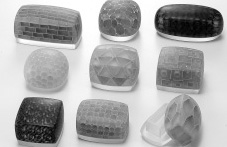 Christensen I think this a very nice idea of this International Exhibition of Glass Kanazawa, or a competition that you give the jury members the possibility at the very end of the assessment to go to the glasses again and make a choice, which is not used at all our professionals to bring things forward to discussion of the first prize in the room where we can look for other things which appeal to us individually in glass. Maybe not in the level of saying “Well, this is a museum piece” or “A prize winner”. As it is also mentioned by Mr. Joel Philip Myers, that here we can pursue some of our personal preferences, so to say, to glass to live with in daily life of museum members or art professors.
Christensen I think this a very nice idea of this International Exhibition of Glass Kanazawa, or a competition that you give the jury members the possibility at the very end of the assessment to go to the glasses again and make a choice, which is not used at all our professionals to bring things forward to discussion of the first prize in the room where we can look for other things which appeal to us individually in glass. Maybe not in the level of saying “Well, this is a museum piece” or “A prize winner”. As it is also mentioned by Mr. Joel Philip Myers, that here we can pursue some of our personal preferences, so to say, to glass to live with in daily life of museum members or art professors.
I have chosen my personal choice, this set of glass made by Itcho Matsuo, which I was told was coming to the former historic class here in Toyama prefecture.
My choice, a set of glass, I’m in a way so conservative that I’m also very much interested in glass as being an important way to express yourself artistically. Then I also sometimes say that first of all it is more than thousand years old crafts which have developed which have collected another experiences and it is very nice that somebody try to be a real good craftsman and in this case series of very nice well-formed well-designed, so to say, small boxes using a lot of different kinds of traditional technique but using that in a very personal way and in the maximum of craftsmanship and making those small very nice craft pieces. I think it is something which was found among the submitted works at the Preliminary Assessment, but you’ve also in between chosen things. Those who were at the assessment didn’t know who would come in the absolute first row. But it had quality of modern glass art.
More excellent part of the glass art couldn’t exist in my opinion. Therefore, this is a choice of mine.
Takeda Next about the piece Jiri Harcuba selected for his award. Mr. Harcuba please.
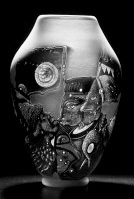 Harcuba My prize goes to Christian Schmidt, a very well-known glass engraver in Germany. He got already a prize at the first International Exhibition of Glass Kanazawa. I’m teaching engraving myself, so I wanted to support this technique which can be only very difficult to compete with glass culture, blown glass and others. I believe that this engraving was conducted to make the work contemporary and this glass piece by Christian Schmidt is more free than it was in the past. The vessels use more layout of glass engraving and in fact creating fine engraving, a kind of painting in glass.
Harcuba My prize goes to Christian Schmidt, a very well-known glass engraver in Germany. He got already a prize at the first International Exhibition of Glass Kanazawa. I’m teaching engraving myself, so I wanted to support this technique which can be only very difficult to compete with glass culture, blown glass and others. I believe that this engraving was conducted to make the work contemporary and this glass piece by Christian Schmidt is more free than it was in the past. The vessels use more layout of glass engraving and in fact creating fine engraving, a kind of painting in glass.
Takeda Thank you. Next I’d like Mr. Yokoyama to make a comments on the work by Takashi Sano from Toyama.
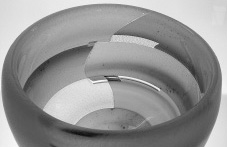 Yokoyama I selected Takeshi Sano’s work for my prize. First I was impressed with its beautiful impression. The form is not so special but it’s an ordinary bowl, yet artist’s way of selecting colors and arranging those colors, and his techniques to create delicate shades of expression make this piece tasteful. I have come across his work several times so far. Each time he has tried new ways of expressing himself. I’d like to appreciate this particular point.
Yokoyama I selected Takeshi Sano’s work for my prize. First I was impressed with its beautiful impression. The form is not so special but it’s an ordinary bowl, yet artist’s way of selecting colors and arranging those colors, and his techniques to create delicate shades of expression make this piece tasteful. I have come across his work several times so far. Each time he has tried new ways of expressing himself. I’d like to appreciate this particular point.
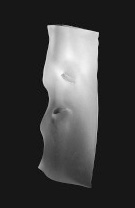 Takeda Thank you.
Next about the piece I selected for my prize. I selected the piece by Mika Okuno applied from Kanazawa. This is quite a big piece. First I was fascinated with its title ”Ma” which is a sort of a Japanese traditional aesthetic sense. In the fields of Japanese performing arts and art in general, this “Ma” is one of the most important aesthetic senses. It plays a significant roll in considering time, space, and something spiritual while performing tea ceremonies or arranging flowers. It exists in paintings and in sculptures. I was very much interested in her idea of titling her piece “Ma”.
Takeda Thank you.
Next about the piece I selected for my prize. I selected the piece by Mika Okuno applied from Kanazawa. This is quite a big piece. First I was fascinated with its title ”Ma” which is a sort of a Japanese traditional aesthetic sense. In the fields of Japanese performing arts and art in general, this “Ma” is one of the most important aesthetic senses. It plays a significant roll in considering time, space, and something spiritual while performing tea ceremonies or arranging flowers. It exists in paintings and in sculptures. I was very much interested in her idea of titling her piece “Ma”.
I have seen several works of hers so far. This piece expresses something indefinite and it doesn’t have any definite forms. The informed body contains a few smaller informed bodies in it, which look as if floating in the outer body due to their transparent and opaque effects of their surface. Looking at this piece from different perspectives, I felt delicate shades of expressions, something like unstable emotions or formative spirits.
First, it is quite difficult to express her ideas of “Ma” into forms. The more you think of it, the more difficult it would be. This artist, anyway, put her ideas into the form by utilizing this particular material, glass.
I’ve been very much interested in this point. I hope that she will be able to build up one of the new ways of expressing the era where we live now by developing new pieces based on such a theme.
Comments on the Final Assessment
Takeda we’d like all the jurors to make open comments on the Final Assessment and after that we’d like to move to the Questions and Answers Time. Please summarise your comments because the symposium time is limited. First Mr. Myers, please.
Myers I think we did sincere and careful evaluation of pieces and looked at each work carefully trying to understand what the works are about. And I think that I feel very satisfied that we were fair and that I’m very pleased and proud to be a part of this jury. Thank you.
Takeda Thank you. Next, Mr. Christensen, please.
Christensen Today thousands of glass artists spread all over the world. It’s nearly an impossible task to find who is leading the process of development of modern glass art. Many places who are earlier involved in taking up the way the exhibitions and competitions of glass art in the world have not given up but have realized that it is really difficult.
In this case here in Kanazawa you have had many years and times experiences in this. When we look at the Preliminary Slide Assessment and the Final Assessment here, you have found, in my opinion, a part of the way especially at the Preliminary Slide Assessment which is very complicated where you have to have jurors who have very great knowledge of what’s going on in glass. It has succeeded to give us in the Final Assessment good possibility to come to the final conclusion. But you have to realize that this is the process where many good artists are involved and we have to make a decision, but they could be happy. Other artists also even more, let them come here now. Thank you.
Takeda Thank you. Next, Mr. Harcuba, please.
Harcuva I think that this is such an important even for the glass people because it’s an only place of the world such a competition. It could be in the USA and it’s not in the Czech Republic yet. So Japan is an only country who pays attention for this activity and as we know from the authority of the town they would like to continue and they would like to support this exhibition also in the future. It is a very good perspective. I think it very important also for Kanazawa and Toyama which are closest glass centers.
You have seen that many many artists from both towns have been very successful. I’d like to congratulate all Japanese artists first of all.
Takeda Thank you. Next, Mr. Yokoyama, please.
Yokoyama My first impression was that as a whole this International Exhibition of Glass Kanazawa 2007 drew many excellent pieces. Especially the pieces made by Japanese artists are quite good. They all are tours de force. The selected pieces at the Preliminary Slide Assessment are made up of a little more Japanese pieces and a little fewer pieces applied from overseas. It was very difficult to selected prize winners out of those excellent works, but I was impressed with the active and stimulating discussions among all the jurors on which one to select and which one to eliminate. They made the Final Assessment quite objective.
Let me talk about something personal. I, myself, make glass works. I always think about how I can manage to create my own pieces with own originality and characteristics. While I’m creating my works, I feel like talking to those who will look at my works. For example, Picaso is Picaso and Mozart is Mozart from any perspectives on their works. Any one of thier pieces expresses their aesthetic senses and humanity. I always create my works wishing that my pieces could be close to such pieces as Picaso’s and Mozart’s
At the Final Assessment of this time, I looked at all the selected pieces by getting ride of many difficult thoughts as if I put brand new film into my mind. Thus I selected the work each time the film in my mind is sensitively exposed to a certain piece. This is my basic way of looking at each work at the assessment.
Takeda Thank you.
Lastly, I’d like to express my opinions. As the other jurors have already mentioned, the level of the selected works is much higher than that of the works at the previous exhibitions. That’s why the assessment was solid and at the same time difficult to forward. Some pieces were so excellent that any of them could have been higher prize winners.
As Mr. Yokoyama had mentioned, all the jurors of the assessment panel strongly hold a sort of concept or stance on the judging criteria in common, which means originality. This originality includes themes, images, execution, and many more. Those aspects have made artists find a new way of expressing themselves. All the jurors looked at the selected pieces expecting such newness which makes them excited. So this time discussions among the jurors helped them find their mutual understanding and judging criteria. I have been the head juror for both the Preliminary Slide Assessment and the Final Assessment. I feel satisfied with the results of both assessments because the results of the assessments have been well-accepted. It’s said that as a whole excellent pieces were selected as prize winners.
All the jurors were satisfied with their discussion because they could openly exchanged their opinions thanks to Yoshiko Hayakawa’s appropriate interpretation.
We’d like to move onto the Questions and Answers Time. To any of the panelists, any honest and frank questions on the winners or glass art itself will be welcomed.

